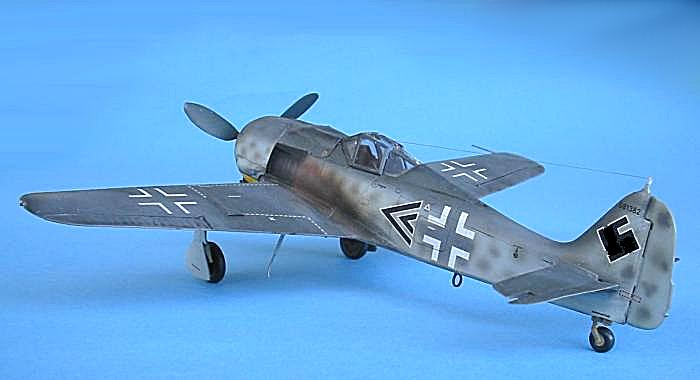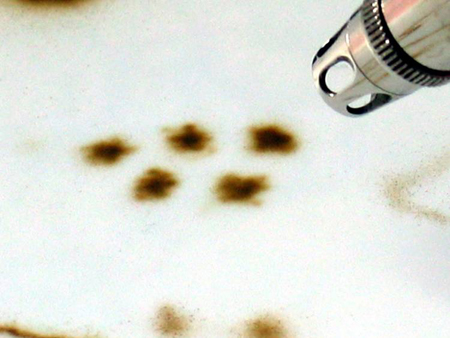Anyone have an easy way to do the mottle camo pattern on 190?
Is there at least a website I can go to to learn to paint it?
Thanks guys,
~chip
General Aircraft
This forum is for general aircraft modelling discussions.
This forum is for general aircraft modelling discussions.
Hosted by Jim Starkweather
Luftwaffe Mottle Paint Question
chip250

Joined: September 01, 2002
KitMaker: 1,864 posts
AeroScale: 410 posts

Posted: Saturday, April 22, 2006 - 11:27 AM UTC
Posted: Saturday, April 22, 2006 - 11:31 AM UTC
Hi Chip
A couple of questions: Do you have an airbrush - and what scale are you working in?
All the best
Rowan
A couple of questions: Do you have an airbrush - and what scale are you working in?
All the best
Rowan

chip250

Joined: September 01, 2002
KitMaker: 1,864 posts
AeroScale: 410 posts

Posted: Saturday, April 22, 2006 - 02:09 PM UTC
I have two airbrushes, and I am working on a 1:48 FW-190 A-3
Posted: Saturday, April 22, 2006 - 05:10 PM UTC
Hi Chip
you could use the mottle maskes frm Eduard or airwaves. or just try free hand and practise (I still have not mastered the task after over 10 years, but maybe I am just a slow or bad modeller)
I would recommend using the finest nozzle you can get. Thin the paint! I have found it is good to use a large portion of clear "color"(besides the thinner) as the paint will be thinner but does not run down the model or build up the splotches. Also use a low air pressure on your compressor .... Did I mention to thin the paint!!!

As I said, I am still prctising although at the moment I also suffer from a worn out air gun
(I need a replacement but cannot afford it ...

 why did I open the airbrush body ...
why did I open the airbrush body ...  well, it was weekend and I needed to finish a project)
well, it was weekend and I needed to finish a project)
cheers
Steffen
you could use the mottle maskes frm Eduard or airwaves. or just try free hand and practise (I still have not mastered the task after over 10 years, but maybe I am just a slow or bad modeller)
I would recommend using the finest nozzle you can get. Thin the paint! I have found it is good to use a large portion of clear "color"(besides the thinner) as the paint will be thinner but does not run down the model or build up the splotches. Also use a low air pressure on your compressor .... Did I mention to thin the paint!!!

As I said, I am still prctising although at the moment I also suffer from a worn out air gun
(I need a replacement but cannot afford it ...


 why did I open the airbrush body ...
why did I open the airbrush body ...  well, it was weekend and I needed to finish a project)
well, it was weekend and I needed to finish a project)cheers
Steffen

flitzer

Joined: November 13, 2003
KitMaker: 2,240 posts
AeroScale: 743 posts

Posted: Saturday, April 22, 2006 - 05:57 PM UTC
Hi
another method worth considering is the reverse mask one.
i.e. spray on the mottle shade first as a overall shade. Then add littkle rolled up balls of blu-tac or similar and spray on the base colour. This method is particularly useful if there are to be large mottled areas.
Hope it helps
Cheers
Peter
 :-)
:-) 
another method worth considering is the reverse mask one.
i.e. spray on the mottle shade first as a overall shade. Then add littkle rolled up balls of blu-tac or similar and spray on the base colour. This method is particularly useful if there are to be large mottled areas.
Hope it helps
Cheers
Peter
 :-)
:-) 
Posted: Saturday, April 22, 2006 - 06:19 PM UTC
Hi Peter
right on! I forgot that one. If I will ever do my He 219 or the night scheme of my He 177 I would use that on as you can control the look before you are done (which is not so critical when doing side mottle on fighters).

cheers
Steffen
right on! I forgot that one. If I will ever do my He 219 or the night scheme of my He 177 I would use that on as you can control the look before you are done (which is not so critical when doing side mottle on fighters).

cheers
Steffen
Posted: Saturday, April 22, 2006 - 07:00 PM UTC
Hi again Chip
Yep - I'd have to agree with Steffen; if you're going to try freehand, you need to have a fine tip for your airbrush, get the consistency of the paint right, and (ideally) control the airpressure. The later is done by a regulator on the compressor and getting the balance between the paint-flow and the air pressure is half the battle. Keeping the pressure low allows you to get in close without blasting too much paint everywhere.


Getting it right really comes with practice, so try spraying on scrap shiny card or old wrecked kits. Why shiny card? Because it's most like the surface of a kit. Test spraying onto paper can be misleading because it's so absorbent - you need a hard surface to spot whether the paint has a tendency to run or not.
Both Steffen's and Peter's methods for masking are good if your airbrush isn't capable of fine work. You can also just punch a small irregular hole in a piece of card and hold it a short distance away from the surface of the model.
But, the key to any spraying is really practice, practice and - you've guessed it - yet more practice.
I hope this helps
Rowan
Yep - I'd have to agree with Steffen; if you're going to try freehand, you need to have a fine tip for your airbrush, get the consistency of the paint right, and (ideally) control the airpressure. The later is done by a regulator on the compressor and getting the balance between the paint-flow and the air pressure is half the battle. Keeping the pressure low allows you to get in close without blasting too much paint everywhere.


Getting it right really comes with practice, so try spraying on scrap shiny card or old wrecked kits. Why shiny card? Because it's most like the surface of a kit. Test spraying onto paper can be misleading because it's so absorbent - you need a hard surface to spot whether the paint has a tendency to run or not.
Both Steffen's and Peter's methods for masking are good if your airbrush isn't capable of fine work. You can also just punch a small irregular hole in a piece of card and hold it a short distance away from the surface of the model.
But, the key to any spraying is really practice, practice and - you've guessed it - yet more practice.
I hope this helps
Rowan

 |















